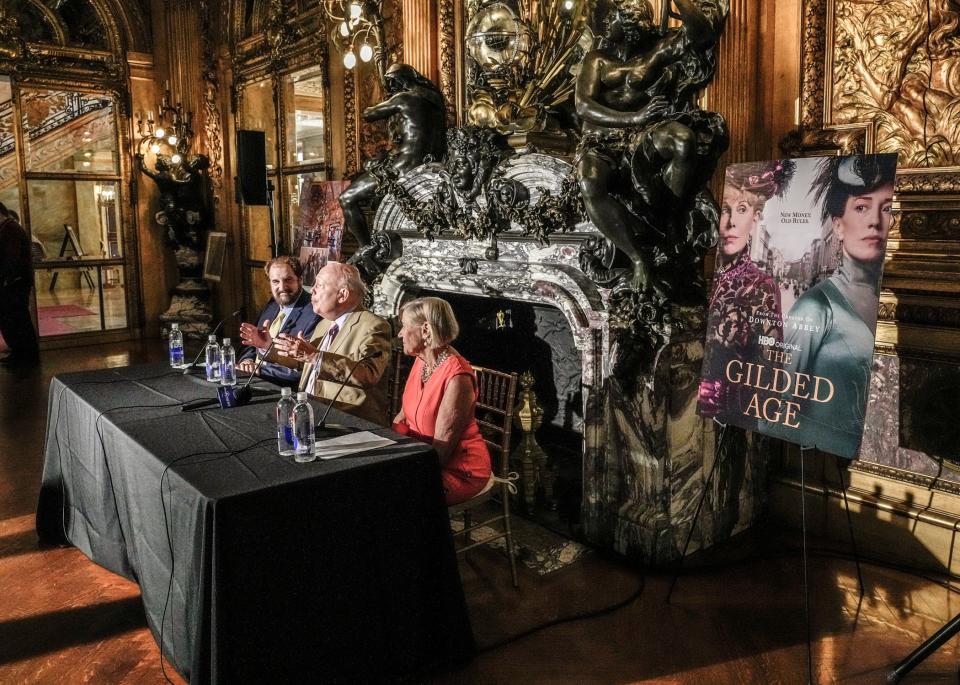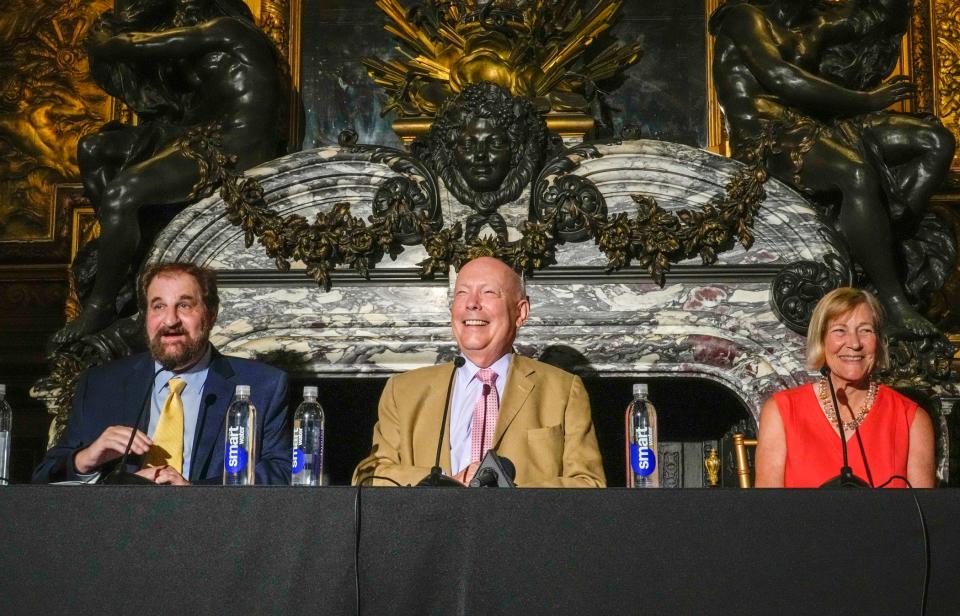Newport finds a bigger role as 'The Gilded Age' comes to life in season 2
NEWPORT – It was the Gold Room, fittingly enough, which caught the eye of "The Gilded Age" creator Lord Julian Fellowes.
As Preservation Society of Newport County CEO Trudy Coxe tells it, it was a dinner at Marble House with a group including Rhode Island Film and Television Office Executive Director Steven Feinberg that sealed the deal on a long flirtation with the idea of filming Fellowes’ 19th century period drama in the City-by-the-Sea.
Lord Fellowes, whose long list of credits also includes the acclaimed British drama Downton Abbey, was taken by the Gold Room in particular and by the cluster of well-preserved Gilded Age mansions in general, and The Gilded Age ended up filming scenes for its first season at The Breakers, Marble House, The Elms, Rosecliff, Chateau-sur-Mer and Hunter House. One of the main characters is moving from New York to Rhode Island in season two, so sharp-eyed locals should expect to recognize even more of Newport in the second season.
'The Gilded Age' in Newport: RI Film and TV claims 'Gilded Age' will boost Newport tourism, but do the numbers add up?

The show, which first aired on HBO in January, is largely set in 1880s New York City, a time when America’s new elite was just beginning to leave its opulent footprint on Newport in the form of its famous, historically preserved and in some cases absolutely gargantuan “summer cottages.”
In addition to a few bona fide Newport scenes, including one featuring the International Tennis Hall of Fame’s grass courts, many of the scenes filmed in rooms from the Newport Mansions are presented as being set in the main characters’ Fifth Avenue homes, a trick of aesthetic cohesion made possible by the historical fact that Robert Morris Hunt was the architect behind many of the most prominent Gilded Age buildings and private homes in both Newport and New York; in addition to the Metropolitan Museum of Art, the pedestal to the Statue of Liberty, and numerous Fifth Avenue mansions, Hunt designed The Breakers, Belcourt and Marble House.
Fellowes reunited with Feinberg and Coxe in the Gold Room ahead of accepting the Preservation Society’s Antiquarian Award at a dinner on July 26 and fielded questions about his creative process, the development of the show and Newport’s key role in many of its historically set scenes.
'Gilded Age' season 2: 'The Gilded Age' resumes filming in Newport. Here's what you need to know
The acclaimed writer was not coy about the similarities between main character Bertha Russell and deceased millionaire Alva Vanderbilt (later Alva Erskine Belmont, after her society-stirring divorce and remarriage to Oliver Hazard Perry Belmont, grandson of Newport’s own Commodore Matthew Calbraith Perry).
Citing Alva’s influence on her contemporaries in Newport in areas including women’s suffrage and the social acceptability of divorce in high society, he said, “She just changed the game…(Newport) was a matriarchal town – I mean women have always dominated high society and they’ve always chosen who was in and who was out…(but) I think Newport was a particularly strong case of this because the male upper-class in America, unlike their European counterparts, still worked.”

He modeled much of Bertha Russell’s personality after the energetic, convention-challenging Alva, who he described as being at the forefront of Newport’s new money set during the Gilded Age, saying, “Alva was very imaginative, and she sort of was inventing the Gilded Age as it went along, and others were taking her lead. I mean, I think that’s the other reason they couldn’t get rid of her when she divorced, because she was really their spiritual leader in so many ways.”
Contextualized by the deep connection between his character and the historical figure she was modeled after, it clearly brought Fellowes great satisfaction to allow Bertha Russell to physically inhabit some of the same spaces as Alva Vanderbilt, using rooms from Marble House, which Alva received as a 39th birthday present and owned until shortly before her death, as stand-ins for the interior of the fictional Russell family’s imagined Fifth Avenue mansion.
'Where the Crawdads sing': When Hollywood came calling, this Newport musician was ready with his conch shell
Fellowes did also weave some real historical characters into his plotlines, such as Caroline Astor and Ward McAllister, the latter played by Nathan Lane. Both were real and powerful socialites of their day, and both were key members of the advanced guard of New York nouveau-riche industrialists moving to Newport in the late 19th century. He explained in one episode of the first season, Bertha Russell tricks Mrs. Astor, applying social pressure on Astor’s daughter in order to achieve the desired outcome from her influential mother. He then revealed that this was based on true events – early on in her social rise, Alva Vanderbilt intentionally neglected to invite Caroline Astor’s daughter to a ball in New York until her mother paid a social call, thus confirming and elevating Vanderbilt’s social status.
The show’s believability seems to come from this meticulous historical research, its careful melding of historical fact with dramatic flair superimposed over a set that is as authentic as possible – at one point, in a scene set in New York, fictional tycoon George Russell hashes out a deal with a city alderman over a game of billiards on the Vanderbilts’ actual pool table at The Breakers. The Elms’ kitchen is featured prominently in numerous scenes involving the Russells’ servants, and in the season finale, The Breakers’ music room is transformed into the Russells’ ballroom. Eagle-eyed viewers might catch a glimpse or two of the Morning Room as well.

While Newport’s mansions already receive millions of visitors, those numbers might increase as the show reaches a wider audience on HBO. The Newport Preservation Society seems to welcome the notion, as it has added some information about filming locations to the generally available audio tours of the mansions and is starting a new weekly Inside “The Gilded Age” Tour exclusively for guests of the Vanderbilt, the Chanler and the Marriott.
In terms of an expert opinion on the best Gilded Age era home in Newport, Fellowes favors The Elms. He said, a bit tongue in cheek, “My house here is The Elms. There’s no doubt about that. I love the whole thing; the entrance, the disposition of the rooms, the dining room, the ballroom I think is one of the prettiest in the town…I love the terrace in the back, I love the garden, and I was very, very pleased that we could use it in the second season.”
This article originally appeared on Newport Daily News: HBO's 'The Gilded Age' returns to Newport for season 2
